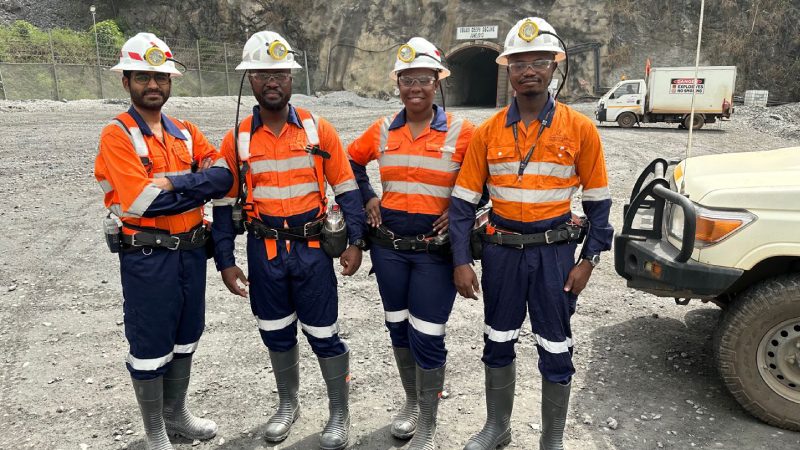Summary
In 2022, a major gold mine in West Africa transitioned from contractor mining to owner-operated mining. To ensure a successful shift, the operation needed to meet defined performance targets across a broad range of operational metrics. Key focus areas, aligned with the owner mining business case, included:
- Real-time monitoring of mobile equipment and critical operational parameters;
- Productivity gains through optimization of payloads, cycle times, equipment availability, and utilization;
- Fuel cost reduction enabled by real-time fuel management, emphasizing haul road maintenance, operator efficiency, and equipment performance.

Solution
To meet the strategic priorities set by the corporate owner, Ramjack deployed its Remote Operations Centre (rROC) solution to drive performance optimization across operational technologies. The rROC is a specialized, off-site control room that enables real-time monitoring, management, and adjustment of mine operations to enhance productivity and operational efficiency.
Beyond optimizing the existing Modular DISPATCH system, Ramjack implemented and operated two complementary technologies:
- Cascadia Scientific – a real-time fuel monitoring and analytics system used to drive productivity and maintenance insights;
- Rayven Dynamix – a predictive analytics platform that leverages DISPATCH data for short interval control to improve equipment utilization.
To deliver on these priorities, Ramjack mobilized a team of eight experts, including:
- A 24/7 engineering team based at the Johannesburg rROC for continuous short interval control;
- Two on-site technicians supporting system uptime and data quality;
- A dedicated fly-in fly-out Application Specialist overseeing KPI delivery and program execution.
Defining the Deliverables
Prior to going live with the rROC service, a collaborative diagnostic workshop was conducted on site. This session was critical in defining the program’s baseline, establishing priority focus areas, and developing a project charter with a detailed workflow and communication plan to guide ongoing activities.
Ramjack and the customer worked closely with technology vendors to deploy the hardware and software required to support the three core priorities. During this phase, it was also agreed that the rROC would extend its monitoring scope to include a fatigue management system implemented under a separate Ramjack initiative.

Results
- The rROC deployment has led to several operational improvements, as well as cost savings across the board. Implementation of new technologies and optimization of existing technology on site contributed to a monthly increase of 10% in payload, resulting in a reduction of cost per ounce and significant savings per month.
- Through enhanced performance in predictive analytics and real-time interventions, fuel usage and maintenance indicators have shown improvement across many parameters. Thanks to predictive maintenance interventions from the program, three engines were protected from failure, equivalent to a savings of up to $1.5 million.
- Early indications from the deployed fatigue management solution shows that it has prevented on average three (3) fatigue-related incidents per month, resulting in a substantial overall improvement in safety – and related costs – of the long-haul operation.
- Continuous and consistent use of the mine’s operational data – both from new and existing technology – has helped identify priority points and improve overall operational discipline. Systems availability, data integrity and converting information to actions continuously reveals opportunities for further efficiency gains and cost savings.
- Thanks to the savings achieved through improved decision-making, predictive maintenance, and optimized fuel usage, rROC provided a return on investment within the first four (4) months of the program. These savings continue to expand as the adoption of the technology improves, with more savings expected to come from ongoing recommendations from the program and improved decision-making driven by AI.
Key success factors
rROC has proved to be a success, despite its deployment in a tough environment. Several factors contributed to the success of the program:
- Introduction and continuous improvement of processes, workflows, and communication plans – the successful implementation of rROC relies heavily on the introduction of workflows that serve the operators on site and provide visibility to all stakeholders. For the rROC to become part of the mines standard operating practices, it must be engrained into the workflow by design. Such processes were co-designed by the customer and Ramjack, adjusted as required to ensure continued effectiveness.
- Adoption of new technology in a pragmatic, evolutionary manner — rROC is deployed through a ‘technology-as-a-service’ approach, which allows it the ultimate agility, flexibility, and scalability. As part of this rROC programme, three new technologies were added to the existing fleet management system. To accelerate the realization of value, the team had to use the technology as it was designed to be used to solve specific challenges. Over time, advances are introduced allowing the technology – and the use of the technology – to continuously evolve.
- Implementation of a clear and collaborative programme structure — effective governance, which includes clear guidelines on a per shift, per day, per week and per month basis is critical. Recurring steering committee check-ins, as well as on-going pro-active communication between teams, ensures mistakes and misalignments can be caught quickly and remedied in a timely manner. The programme structure was designed deliberately to eliminate ‘group think’ while ensuring a focus on what is most important to the mine at any given time.
Conclusion
This case study illustrates how Ramjack’s implementation of its rROC service – in partnership with this mining customer – provided significant improvement in productivity, OEE, and reduced fuel costs – leading to more efficient operations, lower costs of production and long-term bottom-line savings.
Third party remote operations centers are not commonplace in the mining industry. However, the collaborative work between Ramjack and this mining company serves as an excellent example of the changing face of the industry and how improved value realization from real-time operational technologies can be an enabler for achieving a mine operations strategic objectives – even in challenging environments.
